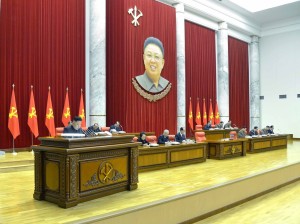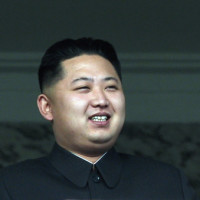 North Korea’s Kim Jung Un – stable is pounding his war drums even louder and warning that he has authorized plans for nuclear strikes on targets in the United States. “The moment of explosion is approaching fast,” the North Korean military said, warning that war could break out “today or tomorrow”. The fearless leader is now regarded as the most unstable head of State in the world. Pyongyang’s latest threat came as Washington scrambled to reinforce its Pacific missile defences, and prepared to send ground-based interceptors to Guam while also dispatching two Aegis class destroyers to the region. Meanwhile, tensions are extremely high on the North’s heavily fortified border with South Korea, after Kim Jong-Un’s isolated regime barred South Koreans from entering a Seoul-funded joint industrial park on its side of the frontier. In a statement published by the state KCNA news agency, the Korean People’s Army general staff warned Washington that US threats would be “smashed by… cutting-edge smaller, lighter and diversified nuclear strike means”.”The merciless operation of our revolutionary armed forces in this regard has been finally examined and ratified,” the statement said. But, while Pyongyang has successfully carried out test nuclear detonations, most military experts believe it is not yet capable of mounting a device on a ballistic missile capable of striking US bases or territory.Mounting tension in the region could however trigger incidents on the tense and heavily militarised border between North and South Korea. The White House was swift to react to Pyongyang’s latest “unhelpful and unconstructive threats”.National Security Council spokeswoman Caitlin Hayden said: “It is yet another offering in a long line of provocative statements that only serve to further isolate North Korea from the rest of the international community and undermine its goal of economic development.”North Korea should stop its provocative threats and instead concentrate on abiding by its international obligations.” US Defense Secretary Chuck Hagel earlier said Pyongyang represented a “real and clear danger” to the United States and to its allies South Korea and Japan. “They have nuclear capacity now, they have missile delivery capacity now,” Hagel said after a strategy speech at the National Defense University. “We take those threats seriously, we have to take those threats seriously. We are doing everything we can, working with the Chinese and others, to defuse that situation on the peninsula.”The Pentagon said it would send ground-based THAAD missile-interceptor batteries to protect military bases on the island of Guam, a US territory some 3,380 kilometres (2,100 miles) southeast of North Korea and home to 6,000 American military personnel, submarines and bombers.They would complement two Aegis anti-missile destroyers already dispatched to the region.This week, the North warned it would reopen its mothballed Yongbyon reactor — its source of weapons-grade plutonium which was closed in July 2007 under a six-nation aid-for-disarmament accord.The US-Korea Institute at John Hopkins University said Wednesday that a satellite photograph seen on March 27 appeared to show construction work along a road and near the back of the reactor was already under way.Experts said it would take at least six months to get the reactor back up and running, after which it will be able to produce one bomb’s worth of weapons-grade plutonium per year.
North Korea’s Kim Jung Un – stable is pounding his war drums even louder and warning that he has authorized plans for nuclear strikes on targets in the United States. “The moment of explosion is approaching fast,” the North Korean military said, warning that war could break out “today or tomorrow”. The fearless leader is now regarded as the most unstable head of State in the world. Pyongyang’s latest threat came as Washington scrambled to reinforce its Pacific missile defences, and prepared to send ground-based interceptors to Guam while also dispatching two Aegis class destroyers to the region. Meanwhile, tensions are extremely high on the North’s heavily fortified border with South Korea, after Kim Jong-Un’s isolated regime barred South Koreans from entering a Seoul-funded joint industrial park on its side of the frontier. In a statement published by the state KCNA news agency, the Korean People’s Army general staff warned Washington that US threats would be “smashed by… cutting-edge smaller, lighter and diversified nuclear strike means”.”The merciless operation of our revolutionary armed forces in this regard has been finally examined and ratified,” the statement said. But, while Pyongyang has successfully carried out test nuclear detonations, most military experts believe it is not yet capable of mounting a device on a ballistic missile capable of striking US bases or territory.Mounting tension in the region could however trigger incidents on the tense and heavily militarised border between North and South Korea. The White House was swift to react to Pyongyang’s latest “unhelpful and unconstructive threats”.National Security Council spokeswoman Caitlin Hayden said: “It is yet another offering in a long line of provocative statements that only serve to further isolate North Korea from the rest of the international community and undermine its goal of economic development.”North Korea should stop its provocative threats and instead concentrate on abiding by its international obligations.” US Defense Secretary Chuck Hagel earlier said Pyongyang represented a “real and clear danger” to the United States and to its allies South Korea and Japan. “They have nuclear capacity now, they have missile delivery capacity now,” Hagel said after a strategy speech at the National Defense University. “We take those threats seriously, we have to take those threats seriously. We are doing everything we can, working with the Chinese and others, to defuse that situation on the peninsula.”The Pentagon said it would send ground-based THAAD missile-interceptor batteries to protect military bases on the island of Guam, a US territory some 3,380 kilometres (2,100 miles) southeast of North Korea and home to 6,000 American military personnel, submarines and bombers.They would complement two Aegis anti-missile destroyers already dispatched to the region.This week, the North warned it would reopen its mothballed Yongbyon reactor — its source of weapons-grade plutonium which was closed in July 2007 under a six-nation aid-for-disarmament accord.The US-Korea Institute at John Hopkins University said Wednesday that a satellite photograph seen on March 27 appeared to show construction work along a road and near the back of the reactor was already under way.Experts said it would take at least six months to get the reactor back up and running, after which it will be able to produce one bomb’s worth of weapons-grade plutonium per year.

KIM JUNG UN-STABLE THREATENS US. PUTS WORLD ON HIGH ALERT!
April 3, 2013










